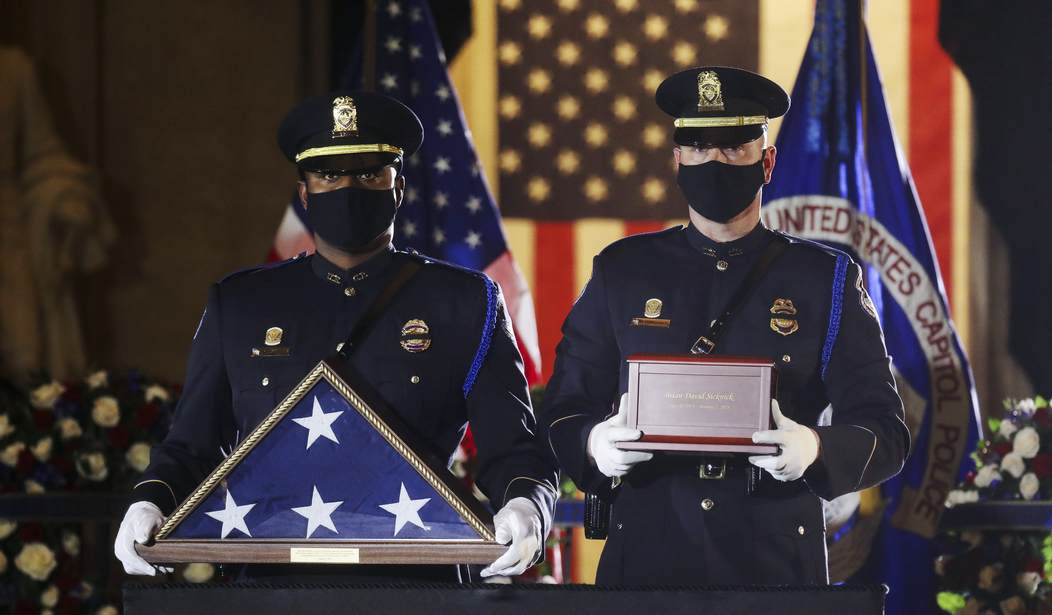What a fiasco the coverage of Sicknick’s death has been — although police sources, the DOJ, and House Democrats share blame with the media for that. The Capitol Police initially claimed Sicknick “passed away due to injuries sustained while on duty,” with two unnamed law enforcement officials whispering to the New York Times back in early January that he was struck with a fire extinguisher. Jeffrey Rosen, the acting attorney general at the time, claimed in a statement on January 8 that Sicknick had succumbed to “the injuries he suffered defending the U.S. Capitol.” On February 2, House Dems filed a pretrial memo in Trump’s impeachment trial alleging that “The insurrectionists killed a Capitol Police officer by striking him in the head with a fire extinguisher.”
But details about the fatal assault remained oddly scarce. In early February, CNN reported that the feds were having trouble building a case against Sicknick’s killers because … they couldn’t find any evidence of an attack on him in the hours of footage of the Capitol riot which they reviewed.
Not only that, one law enforcement source told CNN that there was no evidence of blunt-force trauma on Sicknick’s body. Whatever killed him, it wasn’t a heavy blow.
A few weeks later, a new theory emerged: Sicknick had been assaulted but not with anything that would leave a mark. He was sprayed with bear mace, reportedly, a powerful chemical irritant even more distressing than pepper spray. Possibly he had some kind of extreme reaction to the chemical and died of that. News broke that the FBI had pinpointed video footage of Sicknick being sprayed and not long afterward two men were charged with assaulting him. Not with murdering him, note. Not with manslaughter. Just assault.
Today we finally got an explanation as to why. The medical examiner can’t find any evidence that bear mace caused Sicknick’s death. He had two strokes, which qualifies as natural causes. The odds of convicting anyone for causing his death just collapsed.
The ruling, released Monday, likely will make it difficult for prosecutors to pursue homicide charges in the officer’s death. Two men are accused of assaulting Sicknick by spraying a powerful chemical irritant at him during the siege…
In an interview with The Washington Post, Francisco J. Diaz, the medical examiner, said the autopsy found no evidence the 42-year-old officer suffered an allergic reaction to chemical irritants, which Diaz said would have caused Sicknick’s throat to quickly seize. Diaz also said there was no evidence of internal or external injuries…
Diaz said Sicknick suffered two strokes at the base of the brain stem caused by a clot in an artery that supplies blood to that area of the body. Diaz said he could not comment on whether Sicknick had a preexisting medical condition, citing privacy laws.
So, case closed, then? The insurrection had nothing to do with Sicknick’s death? It was just a coincidence that a 42-year-old man had multiple strokes within 24 hours of the attack on the Capitol?
Maybe not:
The medical examiner noted Sicknick was among the officers who engaged the Capitol mob and said “all that transpired played a role in his condition.”
There’s no elaboration in the story on what that might mean. Maybe the medical examiner suspects but can’t prove that the intense physical and emotional stress Sicknick experienced contributed to the clotting. If so, we’d suddenly face the same issue of proximate cause in Sicknick’s death as in George Floyd’s. In one case a cop was the victim, in the other he was the assailant, but the two are similar in that an assault was perpetrated on someone in an already weakened condition. But for Floyd having drugs in his system, would Chauvin’s knee on his neck have killed him? But for Sicknick’s clotting issue, would the ordeal of January 6 have done him any real damage? The partisan lines will be drawn in the same way in both cases, with the left believing that the assaults were proximate causes of death and the right insisting that each man’s preexisting physical problems were the fatal factor.
Last month the New York Times sifted through video of the insurrection recorded near Sicknick’s position outside the Capitol and managed to isolate the footage in which he was hit by the bear mace. You’ll find it all laid out here. As for why it took police so long to provide the facts on what actually killed him, it could be malice, it could be embarrassment, it could be honest human error, or a bit of all three. Maybe there was a rumor about the fire extinguisher circulating early among law enforcement which was then irresponsibly passed on to the Times by its sources as confirmed fact. Conceivably the rumor was concocted deliberately, because some colleague was understandably angry over Sicknick’s death and believed the insurrection must have played a role and thought the fire extinguisher detail was brutal and vivid. Then, as the police discovered what really killed him, they may have been reluctant to speak up because the fire-extinguisher story had already captured the public’s imagination and it would have been embarrassing to admit that it was incorrect. They probably figured it’d be best to just keep quiet at that point and wait for the medical examiner to set things straight. Which is exactly what happened.







Join the conversation as a VIP Member